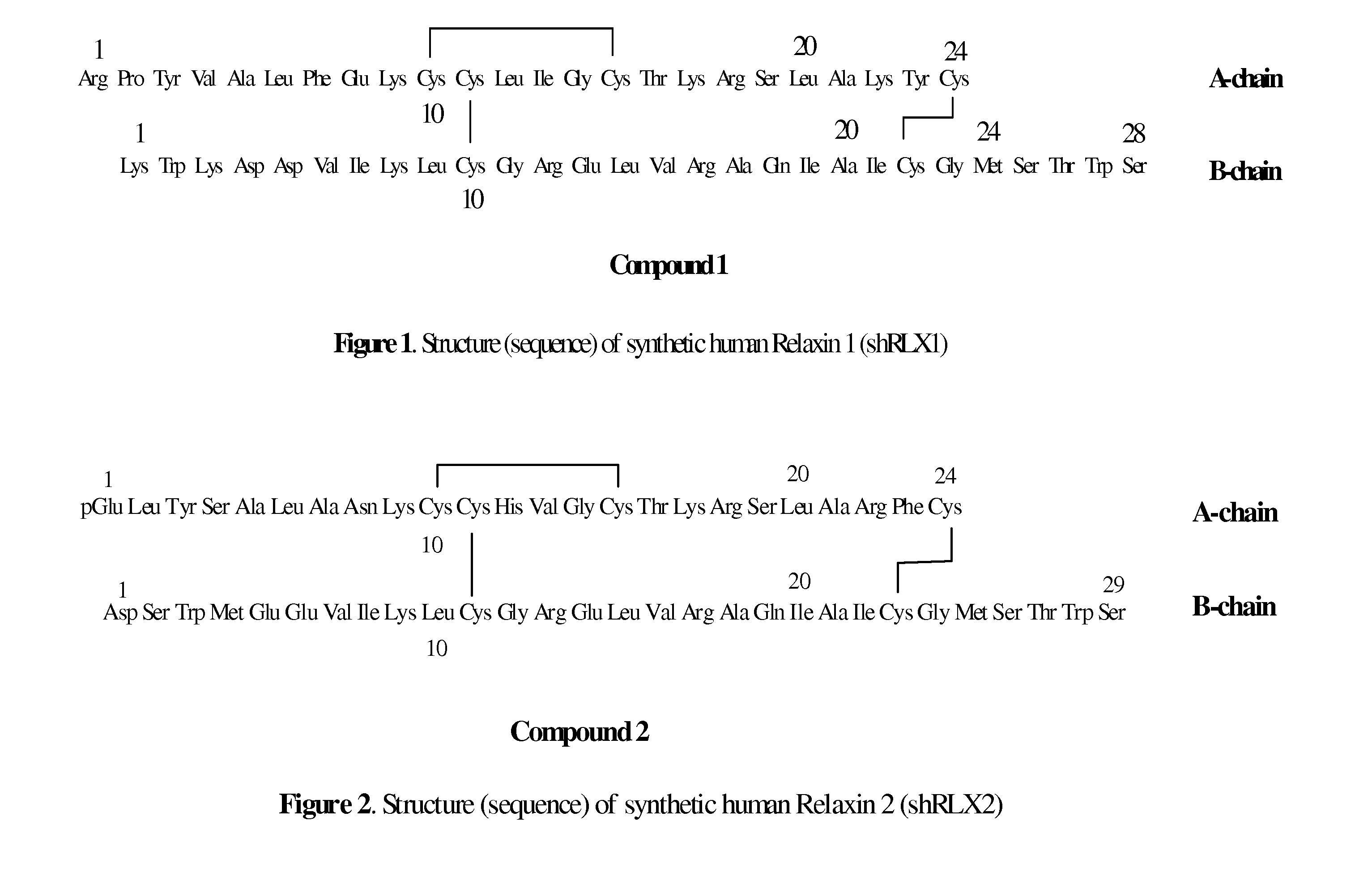Peptide Synthesis
a peptide and synthesis technology, applied in the field of peptide synthesis, can solve the problems of difficult purification of rlxb, for example by chromatographic methods, long and complex recombinant dna techniques, and unsatisfactory production of relaxins on a large scal
- Summary
- Abstract
- Description
- Claims
- Application Information
AI Technical Summary
Benefits of technology
Problems solved by technology
Method used
Image
Examples
example 1
[0092]Solid Phase Synthesis of Human RLX1A, RLX2A, Met(O)24-RLX1B and Met(O)25-RLX2B and of Their Protected Fragments. General Procedure.
[0093]A1. Preparation of Loaded 2-chlorotritylchloride (CTC) Resins; General Procedure:
[0094]CTC-Cl resin (100 g; loading 1.6 mmol / g) was charged to a 2 L peptide reactor and swelled with 700 mL DCM for 30 min at 25° C. The resin was drained and a solution of 100 mmol Fmoc-amino acid and of 300 mmol diisopropylethylamine (DIEA) in 500 mL of dichloromethane (DCM) was added. The mixture was stirred under nitrogen for 2 hours at a temperature of 25° C. Then, remaining active sites on the 2-CTC resins were end-capped with addition of 10 mL of MeOH for 1 hour. The resins were drained and washed twice with 400 mL dimethyl formamide (DMF). The resin was drained, and then treated twice with 500 mL of 25% by volume piperidine for 30 min. The resin was then washed with 500 mL DMF four times. The resin was de-swelled by washing with 3 times 500 mL isopropanol...
example 2
[0112]Deprotection of Linear Reduced RLX1A, RLX2A, Met(O)24-RLX1B and Met(O)25-RLX2B and of Their Derivatives. General Procedure
[0113]The protected RLX-chains A obtained as described above in the example 1 (0.01 mmol) was treated with a mixture 10 mL of TFA / dithiothreitol (DTT) / water (90:5:5) for three hours at 5° C. and for one hour at 15° C. The resulting solution was then concentrated in vacuum and precipitated by the addition of diisopropylether and washed three times with 10 ml diisopropylether. The obtained solid was then dried in vacuum (25° C., 15 Torr) to constant weight. The procedure was repeated with the protected RLX chains B with oxidised methionine groups.
example 3
[0114]Deprotection of Mono and Bicyclic RLX1A, RLX2A, Met(O)24-RLX1B and Met(O)25-RLX2B. General Procedure:
[0115]The protected RLX obtained as described above in Example 1 (0.005 mmol) was treated with a mixture of 5 mL of TFA / triisopropylsilane (TIPS) / anisole / water (91:4:1:4) for three hours at 5° C. and for one hour at 15° C. The resulting solution was then concentrated in vacuum and precipitated by the addition of diisopropylether and washed three times with 5 ml diisopropylether. The obtained solid was then dried in vacuum (25° C., 15 Torr) to constant weight. The procedure was repeated for each chain A and chain B.
PUM
| Property | Measurement | Unit |
|---|---|---|
| pH | aaaaa | aaaaa |
| temperatures | aaaaa | aaaaa |
| temperature | aaaaa | aaaaa |
Abstract
Description
Claims
Application Information
 Login to View More
Login to View More - R&D
- Intellectual Property
- Life Sciences
- Materials
- Tech Scout
- Unparalleled Data Quality
- Higher Quality Content
- 60% Fewer Hallucinations
Browse by: Latest US Patents, China's latest patents, Technical Efficacy Thesaurus, Application Domain, Technology Topic, Popular Technical Reports.
© 2025 PatSnap. All rights reserved.Legal|Privacy policy|Modern Slavery Act Transparency Statement|Sitemap|About US| Contact US: help@patsnap.com



